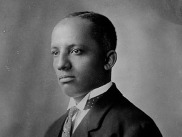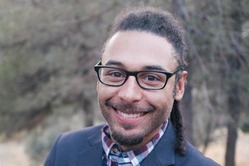
 |
|
|
Open Educational Resources (OER) offer educators an opportunity to not only access high quality instructional materials, but also offer an opportunity to improve them, revise them, make them your own and simultaneously share them with the world. Want to find out more about how to remix, publish and share them on Oregon Open Learning?
Contact us at: OregonOpenLearning@ode.oregon.gov
Do you know of other educators who would be interested in receiving Oregon Open Learning’s Monthly Newsletter? If so, send them this link: OOL Monthly Newsletter or use the QR code to the right.
|
|
Table of Contents
Black History Month
Voices from The Field
Featured Open Educational Resources at Oregon Open Learning
Free Non-OER Digital Resources Focusing on Black History


February is Black History Month, and although Black history should be included and celebrated year round, it is worth recalling that the original celebration of Black history, championed by Carter G. Woodson was first recognized in 1926 and was only one week long. It took another fifty years for a declaration of Black History Month. While heritage months are helpful reminders of our national past, we have seen tremendous progress among social science and humanities educators working to include Black history not merely as the shaded pages of a US History textbook but as a bright thread running through the fabric of the human story. We teach Black history because of its centrality to US and world history.
This month’s COOL newsletter is dedicated to celebrating K-12 Black History Open Educational Resources (OER) as well as listening to the voices of Oregon educators.
Happy February and happy teaching!
~ Amit Kobrowski Social Studies Specialist and the
Oregon Open Learning (OOL) team at ODE
|


Dr. Iton Udosenata
Deputy Superintendent of Salem-Kaiser School District
In my two decades as a public school administrator, high school principal, and social studies teacher, I have observed the transformation of educational paradigms, particularly regarding the integration of Black History into our curriculum. While dedicating February to this cause is commendable, it is imperative that we weave the rich tapestry of Black history into our daily lessons, transcending the confines of a single month.
First and foremost, the journey begins with empowering our educators. The responsibility to impart lessons on Black history and its multifaceted themes is substantial, often venturing into complex and sensitive territories. It is crucial for us as educators to build our self-efficacy, approaching these subjects with a balance of reverence and sensitivity. This involves acknowledging our vulnerabilities and embracing the role of lifelong learners rather than omniscient authorities. By framing our lessons within a context of mutual exploration and respect, we foster a classroom environment conducive to open, meaningful dialogues.
Simultaneously, we must shift the paradigm of learning from a teacher-centric model to one that empowers our students. Encouraging self-guided discovery not only diversifies the sources of knowledge but also instills a sense of ownership in our students' educational journeys. By providing a curated array of resources – books, documentaries, digital archives – we open the doors for our young minds to explore, inquire, and bring fresh perspectives into the classroom. This approach nurtures critical thinking and personal connection with the material, transforming passive listeners into active, engaged learners.
Furthermore, our exploration of Black history should not be geographically myopic. The Black diaspora stretches far beyond the borders of the United States, encompassing a myriad of narratives, struggles, and triumphs. Integrating global perspectives into our curriculum enriches our understanding of race, culture, and the interconnectedness of human experiences. It challenges our preconceived notions and broadens our worldview, preparing our students to thrive in an increasingly multicultural society.
Lastly, and perhaps most importantly, we must remember to infuse joy into our lessons. While the themes of Black history encompass serious and often somber realities, they are also replete with stories of innovation, resilience, and cultural richness. Celebrating the vibrancy of Black art, music, literature, and cultural traditions fosters an atmosphere of positivity and inclusivity. Learning, at its heart, should be an enjoyable journey – one that inspires curiosity, creativity, and a lifelong love for discovery.
As educators, we wield the power to shape the minds and hearts of future generations. By integrating Black history into our daily lessons, we not only honor the past but also lay the foundation for a more inclusive, enlightened future. Let us embrace this responsibility with courage, empathy, and an unwavering commitment to education that truly reflects the diversity of the human experience.
|

Dr. Dyan Watson
Director of Equity and Inclusion - Oregon Episcopal School
Celebrating Black History Month is a bit like celebrating a friend’s birthday. All year long, you want to let that person know how much you love and care about them. You want to hang out with them and celebrate them in everyday ways. And when it’s their birthday, you want to lavish love on them and let them know just how special they are and what they mean to you.
Yes, we absolutely need to have a month in which we highlight the unique contributions and experiences of Black Americans. At the same time, let’s commit to celebrating Black history all year long by integrating books by Black authors, hanging posters with Black people on school and classroom walls, and discussing Black contributions throughout the curriculum, not just in February. And as educators choose which Black pieces of art and history to display and tell, let us be mindful to celebrate resistance, joy, and the everyday-ness of Black people. Read books where the main characters are Black and riding skateboards and are going through the ordinary trials and tribulations of any youth their age. Doing otherwise sends a message of a helpless, downtrodden people. Start with a place that centers the humanity of Black folks.
Be sure to teach about non-Black activists who fought alongside Black folks. That is our history, too. This will teach all students – but especially non-Black students – that they can be allies and can carry on the legacy of activists who fought for fellow citizens. We can only change if we believe we should and that the work is up to us. Last, encourage students and all educators (i.e, administrators, custodians, administrative assistants, coaches) to learn outside of the classroom. Always be ready to hand out lists of books, podcasts, local museum exhibits, and plays for young people, their families, and those who care for them at school to engage with Black experiences outside of the classroom. We will come to see Black history as American history once we come to see Black people as ordinary Americans and celebrate them everyday.
|

Jason Lowery
High School Social Science Teacher
Sunset High School, Beaverton, Oregon
One of the first things that comes to mind when I think about the teaching of Black history is to recognize that Black history is the history of all of us. It is interwoven into the fabric of who we are as a country. It is complex and influences many aspects of our lives. Whether it is education, housing, healthcare, voting, or popular culture we cannot talk about history without talking about Black history. They are inextricably linked. There is both joy and pain. When teaching Black history, it is important to work through those complexities using a thoughtfulness and willingness to think critically about the intricacies of the people, places, and events and their connectedness to the larger story of America.
Another consideration that is so important to understand is that Black history is rich with the contributions of Black folks to the betterment of our society. Take the democratic ideals of justice, freedom, and equality. Principles that are the bedrock of our country. Black folks have been on the front lines of the fight to ensure that those ideals are fully realized. As educators we have the responsibility to bring those contributions to light. Slavery is not the history of Black people. Black history is the Harlem Renaissance and its influence on community and social activism, HBCU’s and their commitment to the uplifting of Black people through education and the understanding that knowledge is power, Malcolm X and Dr. King who spoke truth to power and gave voice to the voiceless, and the Black Panther Party who fed, defended, educated, and looked after the health and well-being of their communities. Black history is the willingness to sacrifice everything for the good of everyone. We can and should share that story.
Finally, Black history is not just history. We can teach the history of Black folks through all curricula. Take the poets and social activists Maya Angelou and Langston Hughes. Or scientists Marie Clark Taylor and George Washington Carver. Mathematicians like Katherine Johnson and Benjamin Banneker. We can use their works as a vehicle to teach and learn about language, science, and math. Black history transcends subject areas and gives us the opportunity as educators to have classrooms and curriculum that are representative and inclusive.
|

Amit Kobrowski
Social Studies Specialist - Oregon Department of Education
Carter G. Woodson’s Black History Week began as an opportunity to highlight Black achievement. Expanding to a month allows for a deeper exploration of Black History. However, a more complete history must include the long histories and multiple perspectives from Africa and the Black diaspora. The 2021 Social Science Standards include the oppression of enslavement, the continued racism of Jim Crow, and the resistance of the Civil Rights Movement. However, if students only encounter the Black past in these examples, we deny them a rich and complex history.
World History textbooks open with an account of evolutionary history originating in Africa. Traditionally, the next time Africa or Africans appear in textbooks, it is as subjects of Portuguese or Dutch explorers searching for trade routes and enslaved labor. Students deserve to learn about the complexity of the African past predating European exploration and colonization. The history of African states and the significance of Ghana, Mali, Songhai, Aksum, and Zimbabwe play in modern world history are the subject of Howard French’s fascinating “Born in Blackness” and should be part of any comprehensive world history course.
Often when we teach US History, we tell the story of the difficulties and achievements of fulfilling the promises of the founding ideals of pluralistic democracy. The Black experience in America is a powerful lens for viewing our shared history. The contributions and achievements of Black Americans, despite racist laws and slavery, begins well before the US Civil War. Black individuals from early US history, such as Crispus Attucks or Phillis Wheatly, are usually highlighted in US textbooks. We should also include the histories of institutions such as the Black church, Black journalism, and Black-led abolitionist societies that allow students to learn through the voices and actions of Black Americans. Texts like John Hope Franklin’s “From Slavery to Freedom” and Lerone Bennett Jr.’s “Before the Mayflower” are classics offering a sweeping account of Black History's centrality to the American story. The numerous books of Henry Louis Gates Jr. provide additional modern scholarship on elements of Black history. “Stony The Road” and the young adult version, “Dark Sky Rising,” explore the relevance of the post-Reconstruction era and the rise of Jim Crow in understanding current issues of race in America and the continued journey to a thriving and just pluralistic democracy.
We can continue the celebration of Black history for twenty-nine days in February. However, as we strive to live up to the ideals of “a more perfect union,” we must teach a more complete history. A history not segmented like a patchwork quilt of monthly recognitions, but as in the words of Dr. Martin Luther King, “a single garment” that must cover us all in a “network of mutuality.”
|

Zachary Stocks
Executive Director of Oregon Black Pioneers
Be sure to check out their fantastic lesson plans for Oregon educators!
Our mission is to research, recognize, and commemorate the history and heritage of African Americans in Oregon.
I would hope that educators recognize that Black history is important for students of all races and ethnicities to learn. Students (and teachers) should consider how the story of America can in many ways be told through the perspective of Black Americans, tracking our earliest arrival on this continent as slaves to assuming the highest office in the land. This progress was made possible by centuries of legal, social, scientific, military, and cultural contributions to American identity by Black leaders and their allies.
I would also hope that educators can include more than the bare minimum of Black history content in their instruction. I sometimes refer to this as the "Civil War to Civil Rights pipeline"; so often the only times when Black people are mentioned is ~1850-1868 or ~1955-1968.
The Black American experience is far more expansive than this, and deserves attention.
|

Over 70 Oregon Open Learning Black History OER
Primary:
Mary McLeod Bethune and Character
Overview: In this lesson, students will explore the biography of Mary McLeod Bethune and primary resources related to her life in order to understand the impact she had on other people, and how her example of integrity and principle can affect their own lives today
African American Biography Research
Overview: Students will learn the research process by researching an African American Hero. They will use the Oregon Library Information System's 4 step process:1. Plan2. Find3. Create 4. Present
Middle School:
Civil Rights Leader Mary Frances Early
Overview: This lesson plan opens with reflective questions that ask students to reflect on their prior knowledge of Civil Rights leaders. Students then watch, analyze, and respond to an introductory video that presents an overview of Mary Frances Early's life and accomplishments. Next, students engage in an engagement activity, where they view seven video clips that detail various aspects of Early's life, including her childhood, her admission to the University of Georgia and accomplishment as the first African American student to graduate from the university, and her accomplishments and challenges throughout her life. Students then conduct research and compare Early to another Civil Rights leader of choice, preparing a presentation to share with their peers. The lesson concludes with a reflective video and writing prompt.
The Relationship Between Clothing, Race and Politics
Overview: Stanford University law Professor Richard Thompson Ford discusses the connection between race and clothing in the United States. He explains laws relating to dress codes and how clothing was used during the civil rights movement. Activity includes questions for written response and/or discussion.
High School:
African American Soldiers in World War I
Overview: This collection uses primary sources to explore the experiences of African American Soldiers in World War I. Digital Public Library of America Primary Source Sets are designed to help students develop their critical thinking skills and draw diverse material from libraries, archives, and museums across the United States. Each set includes an overview, ten to fifteen primary sources, links to related resources, and a teaching guide.
A Raisin in the Sun: Jim Crow, Home Ownership, and the American Dream
Overview: Learn how Jim Crow laws impacted home ownership and the pursuit of the American Dream in this series of videos from the American Masters film, Lorraine Hansberry: Sighted Eyes/Feeling Heart. Lorraine Hansberry’s family was at the forefront of fighting segregation in Chicago in the 1940s, even taking the fight all the way to the Supreme Court. Hansberry’s famous play, A Raisin in the Sun, continues the legacy of her parents by using literature to take a stand against racial inequality and injustice.
Support materials include discussion questions, teaching tips, and a student handout comparing the experience of Lorraine Hansberry’s family and the Younger family in A Raisin in the Sun.

Oregon Black Pioneers - Educator Lesson Plans
177Unites.org - The Woodson Center's 1776 Unites site "represents a nonpartisan and intellectually diverse alliance of writers, thinkers, and activists focused on solutions to our country’s greatest challenges in education, culture, and upward mobility."
NEH EDSITEment: Teacher's Guide African American History and Culture in the United States
The Association for the Study of African American Life and History (ASALH)
PBS Learning: Celebrating Black History & Culture
The Smithsonian Learning Lab: 190 Collections for Black History
The Smithsonian National Museum of African American History & Culture
Library of Congress:
Illustrated Research Guide on African-American History and Culture. The Manuscript Division has one of the nation's most valuable collections for the study of African-American history and culture.
#LibraryofCongress - Celebration of African American History Month. Social media posts on Black History that can be copied and/or adapted for personal and/or institutional social media accounts.
African American History Online: A Resource Guide. Over 400 years of the African American experience are documented through primary source materials at the Library of Congress. This guide provides access to digitized collections, search strategies, and external websites related to the topic.
Black History Month: A Commemorative Observances Legal Research Guide. A guide that provides the legislative history, proclamations, and laws related to establishing and designating Black History Month (February).
Please Note: Unless hosted, facilitated, or published by The Oregon Department of Education (ODE), these resources have not been endorsed by ODE, but are being shared as relevant opportunities for education professionals to consider.
Questions, comments, or additions? Please get in touch with the ODE Oregon Open Learning team at OregonOpenLearning@ode.oregon.gov. Did someone forward you this newsletter? Want to stay connected with OER at the Oregon Department of Education? Subscribe to the OOL Newsletter Quarterly Newsletter!
|